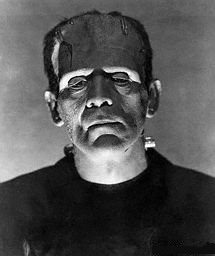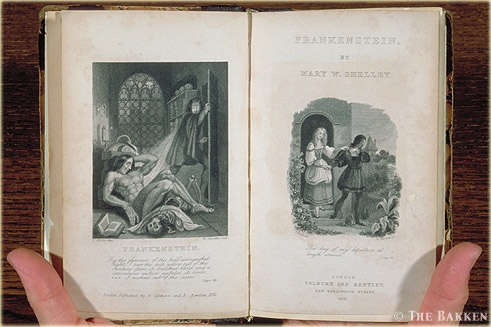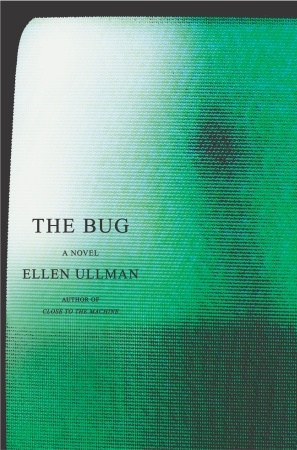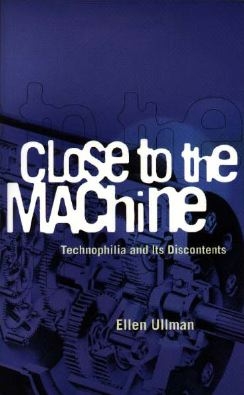 |
|
A monster who has touched many lives. |
|
|
|
A Look at Mary Shelley's 'Frankenstein' and Ellen Ullman's 'The Bug'
Commentary by Katie Dean
The Agony Column for July 31, 2003
 |
|
A monster who has touched many lives. |
A recent review in Elle Magazine wrote the following comments about Ellen Ullman's 'The Bug', "Ullman, author of 'Close to the Machine', the acclaimed memoir of her career as a pioneering software engineer, has taken the raw material of those years and transformed it into an updated 'Frankenstein'. Think Mary Shelley in Silicon Valley". An initial reading of the two novels may indeed suggest some similarities in the storylines, but in fact the fundamental themes of each novel are very different. This column will firstly take a brief look at the elements of 'The Bug' that engendered the original comparison before going on to argue that this comparison is rather misleading and probably unfair to both authors.
 |
|
A to-die-for first edition of 'Frankenstein'. |
A cursory look at each storyline does indeed suggest a number of striking similarities. 'Frankenstein' is about a man of scientific genius whose all-consuming project is to create life. He throws himself wholeheartedly into his work to the exclusion of all his friends and family and eventually achieves his aim. However, the life he creates takes the form of a horrendous monster over whom Frankenstein has no control. This monster takes over Frankenstein's life so that the young scientist remains obsessed in a far more sinister manner and is forced to watch as his happy life surrounded by friends and family is destroyed.
 |
|
Ellen Ullman's 'The Bug' is a tale about an ambitious but unconfident programmer. |
'The Bug' also focuses on a man of some talent who becomes obsessed by his work as a computer programmer. He too dreams of creating life, but in this case it is virtual life. Computer programming is in itself a means of creating an independently functioning machine. Ethan Levin's private hobby sees him explicitly attempting to play God; it involves writing a program based around simple rules that attempts to create a world in which virtual beings survive or die. However, the 'life' that Ethan actually succeeds in creating takes the form of a computer bug in the code he is writing at work, but unlike Frankenstein's monster its creation was accidental. But just as the monster becomes the controlling force in the lives of Frankenstein and those close to him, so Ethan Levin's bug comes to dominate his life and appears to be determining the fate of his colleagues. In the end both men are destroyed by their creations. Both of these novels appear to be about scientific curiosity, a fascination with creating life and obsessive behaviour. The overriding message could be that attempting to play God can only lead to destruction.
Unfortunately, neat as this comparison would be, it only picks out certain elements of each novel and as such becomes detrimental to a proper understanding of the two writers. 'Frankenstein' has unfortunately entered popular myth in much this form - man creates monster, monster is evil and destroys its creator. Most people have heard of 'Frankenstein' and are familiar with this myth, so many see no reason to actually read the novel, thus remaining ignorant of the other, arguably more important, ideas Shelley voiced. 'The Bug' may be well written, but is unlikely to become a piece of classic literature in quite the same way. However, it would be equally unfortunate if it became known only as a story about a programmer who creates a computer bug with a mind of its own that goes on to destroy its creator. This interpretation artificially forces the novel to take on the shape of a modern day Frankenstein story and brushes aside much of what Ellen Ullman is really trying to say. A closer reading of these two novels will demonstrate the differences between the novels while emphasizing the strengths of each.
The first fundamental difference lies in the types of people who form the central characters in each story. In Mary Shelley's work, the young scientist Victor Frankenstein is popular and loved by everyone. He is very much a part of society, but voluntarily chooses to lock himself away in order to create his monster and later in order to protect those around him by destroying that same monster. Victor Frankenstein is the major character in Shelley's novel although his story is told through the medium of another young man in whom Frankenstein confides. It's perhaps dangerous to know him, but not unpleasant.
 |
|
A Virtual portrain of Ellen Ullman showing her links on Web. |
In contrast, Ethan Levin possesses a very unattractive personality and is in many senses rather a social outcast. He has no family and no real friends, he is unpopular with his colleagues and cannot form a successful relationship. He also shares the limelight with another character, Roberta Walton. Ullman reveals less of Roberta's personality, but she too has some difficulty in forming personal relationships. Ethan displays an obsessive nature that is undoubtedly a partial reflection of his personality, but also seems to have something to do with programming, as Roberta finds out for herself.
 |
|
Ellen Ullman's non-fiction work examines the monsters created by the software industry. |
The created beings that form the centre of each novel reflect the second major difference between Ullman's and Shelley's works. Frankenstein's monster was deliberately created and is a thinking being with a personality and a free will. In contrast, the bug at the centre of Ullman's novel was created unintentionally and is only a piece of computer code which cannot possibly have a personality or will of its own. Unfortunately, the erroneous code that is responsible for the bug remains hidden. A series of human errors initially prevent the requisite core code being captured for analysis. However, the real problem stems from the fact that the bug appears at random, usually at inopportune moments in front of potential clients or investors. The bug also appears more serious to the eyes of those outside the world of programming than it actually is. These factors combine in the human mind so that this inanimate force appears to have a will of its own and becomes symbolic of all the problems any start up company faces. The reader of 'Frankenstein' knows that the monster described is effectively a human being, whereas the reader of 'The Bug' is equally sure that behind the strange behaviour of Ethan Levin's creation lies a rational, impersonal explanation.
 |
|
Mary Shelley on the outside. |
The difference between the creations as opposed to the similarities between the creators make it clear that Ullman and Shelley are following very different agendas. Mary Shelley is largely concerned with the way in which society judges people and how those judgements can shape the personality of those under scrutiny. Victor Frankenstein possesses attractive looks and personality and is successful and popular. Even when his monster begins to destroy the lives of his friends and family and Victor intimates that he is to blame, his family refuses to believe that he could have anything to do with such evil. As the disasters increase, Victor's personality reveals a degree of selfishness and lack of compassion that is far less attractive than his old sunny nature. However, his friends and family still offer only love and support. In contrast, the monster possesses a loving nature, but his appearance is so disturbing that he is insulted and rejected by every human with whom he tries to make contact. Any misfortunes are blamed upon him and it is this treatment that makes him evil and vindictive. In an effort to realise happiness he forces his presence upon his creator and demands compensation for his sufferings, but even his creator refuses to show sympathy with his plight. Mary Shelley is concerned with the superficiality of human interaction within society and the way in which that can make or destroy individuals.
 |
|
Ellen Ullman, girl geek. |
'The Bug' is far more introverted in its theme. Ellen Ullman takes the reader inside the head of a man on a journey towards self-knowledge that becomes a psychopathic roller coaster ending in tragedy. Inevitably the society in which Ethan exists has some influence upon him, but Ullman's primary concern lies with his obsessions and the often-warped interpretations he places upon events. Ethan becomes obsessed with his bug by his own free will, not because the bug itself is a living, thinking being who demands attention. Roberta Walton appears in the novel as the force of reason. She provides the reader with a balanced view of events and a third person perspective on Ethan's and budding psychopathic personality. Roberta ultimately unravels the mystery of the bug and in so doing finds her own niche in life, proving that this bug can be a positive as well as a destructive force. Ellen Ullman has created a fascinating novel exploring a man's ability to self-destruct contrasted with a woman's ability to build.
Undoubtedly similarities do exist between 'Frankenstein' and 'The Bug', but there are also crucial differences in the two authors' literary aims. Mary Shelley has a hidden agenda that almost certainly reflects her personal experiences. Her parents, her husband, and even she herself all acted in a manner that went against the accepted social and moral codes of their day. Society's view of Shelley and those close to her was based upon their actions rather than their characters, something that Shelley must have resented. Shelley's message to her readers is to beware of false judgements based on outward appearances. Ellen Ullman's novel does not ask the reader to learn any lessons, but simply to take a look into a world that literature seldom visits. Ullman writes a fascinating story, both compelling and disturbing that is surely not a simple reworking of 'Frankenstein'. Both novels are frightening, not for their monsters, but for their glimpses into the ugliness of the human soul.